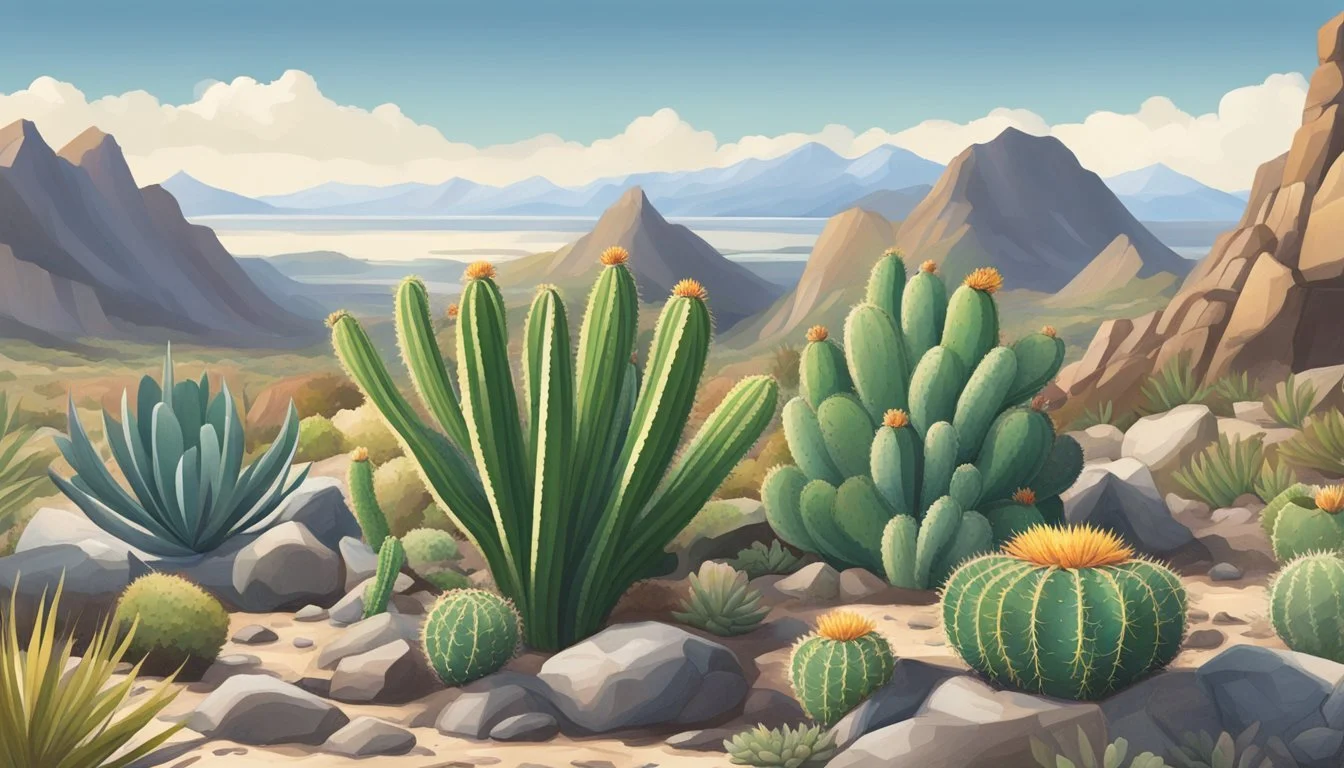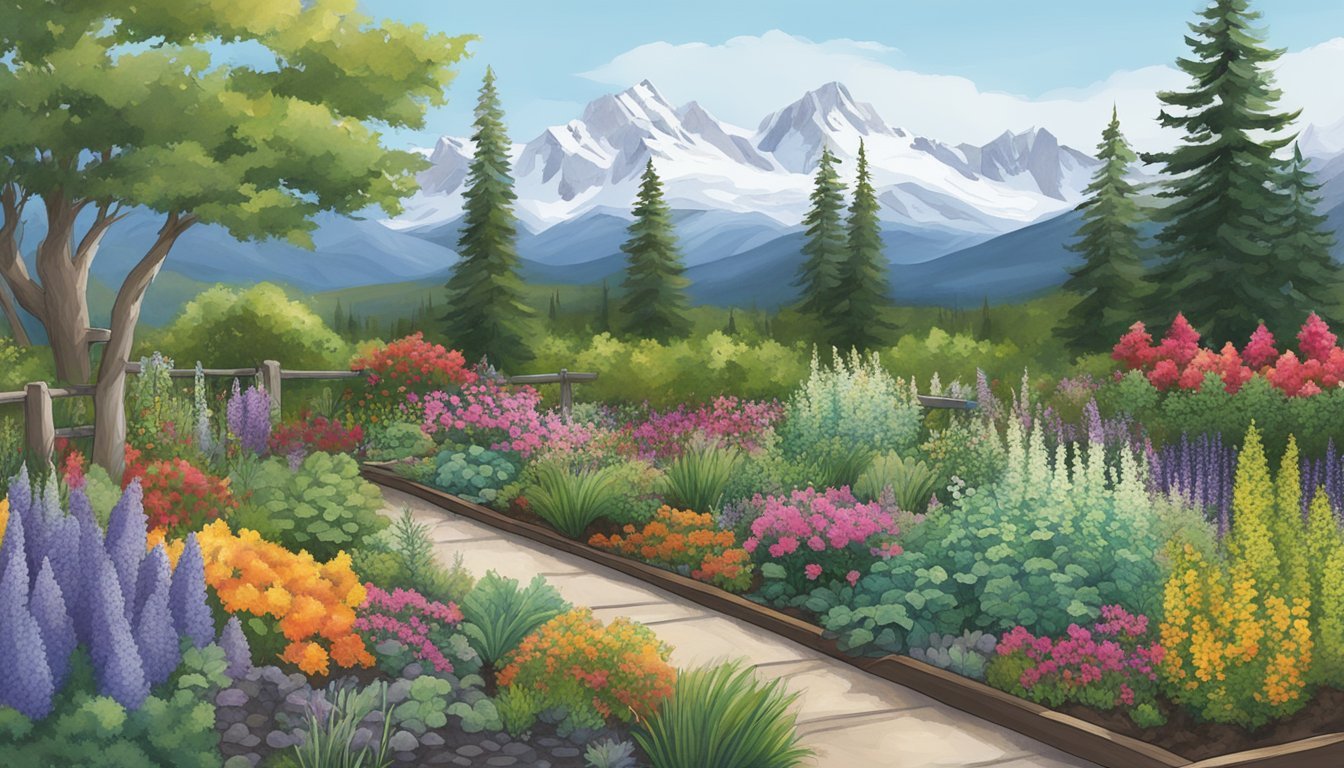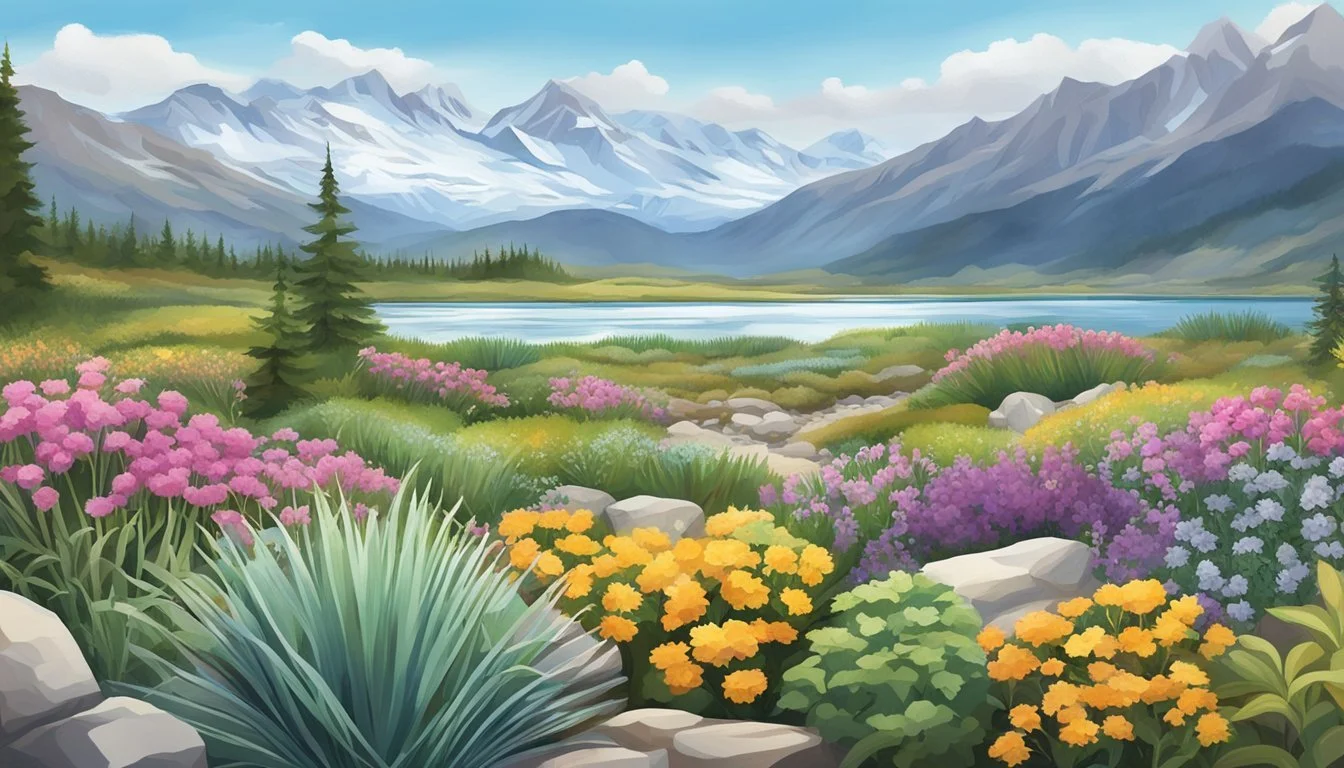Drought-Tolerant Plants in Alaska
Adapting to a Changing Climate
In the challenging climates of Alaska, gardeners and landscapers face unique obstacles when cultivating plant life. The harsh, cold environment necessitates the selection of plants that are not only cold-tolerant but can also thrive with minimal water during drier periods. Drought-tolerant plants offer a practical solution, conserving water without sacrificing the aesthetic appeal of green spaces. These resilient species are particularly valuable as they ensure survival and continuity of the landscape, even in unfavorable conditions.
Alaskan native plants, adapted to local conditions through generations, often demonstrate impressive drought tolerance. For example, the White yarrow is well-suited for Alaskan weather, being able to grow in clumps and withstand varying degrees of moisture availability. Similarly, Alaska's flora includes certain low-maintenance flowers like the aster, which blooms prolifically despite less water, showing a natural predisposition for drought resistance.
Integrating these plants into garden designs or public spaces not only makes environmental sense but also economic, reducing the need for resources and upkeep. Through careful selection, the cultivation of drought-tolerant plants supports a sustainable approach to gardening in Alaska's unique ecosystem, maintaining its natural beauty and biodiversity.
Understanding Drought-Tolerant Plants
Drought-tolerant plants possess unique adaptations that enable them to thrive in environments with limited water availability. In Alaska, these plants are becoming increasingly critical due to the shifting patterns caused by climate change. Characteristics of these plants often include deep root systems capable of tapping into scarce moisture reserves, and leaves designed to minimize water loss.
When considering drought-tolerant species for landscaping or agricultural purposes, one must take into account the native flora and their inherent resilience. These plants typically require less watering, contributing to conservation efforts and providing an economical benefit.
Key Traits of Drought-Tolerant Plants:
Deep Root Systems: Access lower soil moisture
Reduced Leaf Area: Limits transpiration
Waxy Leaf Surfaces: Reduces water loss
Dormancy Periods: Survival during extreme drought
In the face of climate change, selecting plants that naturally withstand arid conditions is becoming a strategic approach to maintain a sustainable environment. These species play a crucial role in preserving the ecological balance, mitigating the environmental impact of water scarcity.
In Alaska, embracing drought-tolerant plants not only supports local biodiversity but also fosters a garden or landscape that is in harmony with the region's changing climate conditions. It's essential to equip oneself with knowledge about these plants and consider their myriad benefits in a comprehensive gardening strategy.
Characteristics of Drought-Tolerant Flora
Drought-tolerant flora in Alaska has developed unique traits to thrive in challenging environments where water is scarce. These plants exhibit a fascinating blend of resilience and beauty, often requiring less maintenance from gardeners.
Adaptations to Dry Conditions
Drought-tolerant plants possess specialized adaptations that allow them to conserve water. Succulents such as sedums store water in their thick, fleshy leaves. Many hardy species have deep root systems that tap into underground moisture, while others may have smaller leaves to reduce transpiration. Some plants improve their survival odds by displaying gray or silvery-gray foliage to reflect sunlight and minimize water loss.
Physiological Traits
The physiological traits of these plants are central to their survival. Flora such as ornamental grasses have narrow leaves which reduce water loss. They can also enter a state of dormancy during dry spells, springing back to life when moisture returns. Rosette-forming succulents avoid water loss by tightly clustering their leaves.
Varieties and Their Textures
Alaskan drought-resistant flora varies not only in species but also in texture. From the rough, spiky leaves of sedums to the soft, feathery fronds of tall grasses like feather reed grass, texture plays not just a practical role in water conservation but also adds aesthetic diversity to the garden.
Visual Appeal
In terms of visual appeal, drought-tolerant flora offers a wide array of colors and forms. Ornamental grasses may display arching clumps with green leaves that turn golden in the fall. Flower spikes can appear in shades of pink or blue, attracting pollinators and adding dynamic movement to the landscape.
Reproductive Strategies
Drought-tolerant plants often have robust reproductive strategies to ensure the survival of the species. They can propagate through various means such as seedlings, bulbs, and rhizomes. This diversity allows them to quickly colonize areas with poor soil where other plants wouldn't thrive.
Survival and Growth
In harsh Alaskan conditions, the ability to survive and grow with minimal resources is crucial. Plants like ornamental grasses develop strong, fibrous root systems that make them hardy and capable of withstanding long periods without water. Their ability to survive in well-draining, nutrient-poor soil also minimizes competition from weeds.
Maintenance and Care
Maintenance for these species is generally low-maintenance. It's important to minimize overwatering to prevent root rot. Deadheading spent flowers helps promote new growth, and reducing fertilizer application can encourage plants to develop stronger, more drought-resistant features. Adherence to water restrictions doesn’t significantly impede their beauty, making them ideal for eco-friendly gardening.
Plant Selection for Alaskan Climates
Selecting the right plants for Alaskan climates involves considering species that can withstand dry conditions while thriving in the region’s unique environment.
Native Drought-Resistant Species
Alaska's native flora has evolved to survive in its diverse climates, including dry areas. White spruce and black spruce are coniferous trees that exhibit resilience in drier soils. The quaking aspen is another native tree known for its adaptability and striking golden foliage in the fall. Among the resilient native shrubs and perennials, species like wild artemisia and yarrow (Achillea) stand out for their drought tolerance and ability to support local wildlife.
Non-native Adaptive Species
Many non-native plants have adapted to Alaska's distinctive conditions. Gardeners have success with species like lavender and thyme, drawing from their Mediterranean origins that predispose them to drier climates. When introducing non-native species, it is crucial to ensure they are not invasive and can coexist with the local ecosystem.
Plant Categories Suitable for Alaska
Alaska's gardening zones support a range of plant categories, including:
Trees: Beyond native species, certain drought-tolerant trees can be successful.
Shrubs: Hardy shrubs that can withstand drier climates.
Perennials: A variety of perennials provide year-round interest.
Grasses: Ornamental grasses add texture and movement.
Ground Covers: An essential component to protect soil and conserve moisture.
Popular Drought-Tolerant Plants in Alaska
For vibrant gardens, Alaskan gardeners can turn to asters, penstemon, and coneflower (Echinacea) for color. Sedum varieties offer attractive foliage and flowers with high drought resistance. Salvia and Lavandula (lavender) stand out for their aromatic leaves and flowers, which are highly attractive to pollinators.
Ornamental and Functional Uses
Drought-tolerant plants are not merely survivalists; they offer ornamental value for garden design and landscapes. Mixed borders can benefit from the structural diversity of shrubs and grasses, with ferns and vines providing additional textural contrast. Ground covers serve as functional solutions to cover large areas with foliage that can endure dry conditions. Moreover, incorporating edible herbs such as oregano caters to practical uses, providing fresh flavors for the kitchen while contributing to a sustainable garden ecosystem.
Cultivation and Propagation
Successful cultivation and propagation of drought-tolerant plants in Alaska require meticulous attention to soil quality, planting strategies, and continuous care. The following subsections provide practical guidance tailored for gardening enthusiasts aiming to thrive in the unique challenges of Alaskan climates.
Soil Preparation
The foundation of healthy plant growth in Alaska's occasionally poor soil is thorough soil preparation. Gardeners should aim for well-draining soil that accommodates dry spells. Incorporating organic matter can improve soil texture and fertility. It's crucial to perform a soil test to adjust pH levels as most drought-tolerant plants favor a neutral to slightly acidic pH.
Planting Techniques
Planting techniques vary depending on the plant species. For seeds, ensure adequate spacing to promote air circulation. When planting bulbs or rhizomes, place them at a depth three times their diameter. Propagation of seedlings should be undertaken in early spring or late summer to optimize root establishment before extreme weather.
Water Management
Effective water management is key during establishment and the occasional dry spells. Gardeners should implement dripping irrigation or soaker hoses to deliver water directly to roots, reducing wastage. During water restrictions, prioritize watering young plants and those showing signs of stress, and always water during the cooler parts of the day to minimize evaporation.
Fertilization and Weed Control
Due to the risk of over-fertilization during dry periods, a slow-release fertilizer appropriate for the specific plant species is recommended. It should supply essential nutrients over a longer period. Regular weeding is necessary to reduce competition for water and nutrients. Mulching also helps in weed suppression and moisture retention.
Garden and Landscape Design
In Alaska's climate, careful consideration must be given to create a garden and landscape that is not only visually appealing but also functional and sustainable. Incorporating drought-tolerant plants can offer a harmonious balance between the natural ecosystem and human design, accommodating the unique challenges posed by local weather patterns.
Planning for Aesthetics and Functionality
When designing a garden, gardeners should first assess the site's specific conditions such as soil quality, sunlight exposure, and drainage. It's crucial to create a plan that combines color, texture, and varying heights to achieve a visually engaging space. Landscapes can include mixed borders that blend ornamental grasses and drought-tolerant plants, which both add visual interest and reduce maintenance needs.
Incorporating Drought-Tolerant Plants
Drought-tolerant plants are essential for a low-maintenance Alaskan garden, as they can withstand dry spells without frequent watering. Some ideal choices include native grasses like blue oat grass and fescue, which provide texture and movement. For ground covers, creeping thyme and sedum are effective options that add lushness to the garden with minimal water requirements. These plants should be positioned strategically within the garden design to maximize their visual appeal and functionality.
Supporting Wildlife and Pollinators
A well-designed garden should not only cater to the aesthetic preferences of gardeners but also support wildlife and pollinators. By selecting native flowers and plants, gardeners help sustain local pollinators such as bees and butterflies, which are vital for a healthy ecosystem. Plant choices like lupine and fireweed can offer abundant nectar and pollen, promoting biodiversity.
Maintenance and Seasonal Care
Regular maintenance ensures that gardens remain attractive and functional throughout the seasons. It includes deadheading flowers to encourage new blooms, watering plants during prolonged dry periods, and applying fertilizer sparingly, as over-fertilization can harm drought-resistant plant species. As seasonal changes in Alaska can be extreme, gardeners need to prepare landscapes to endure shifts, such as mulching before winter to protect the plants.
Environmental Benefits and Considerations
Incorporating drought-tolerant plants into Alaskan gardens offers substantial environmental benefits, particularly as regional climate shifts extend growing seasons and increase average temperatures. These strategies help in supporting diverse wildlife and minimizing the need for extensive watering and fertilization.
Eco-Friendly Gardening Practices
Gardeners in Alaska can adopt eco-friendly gardening practices by choosing drought-tolerant plants that require less watering. This minimizes the ecological impact and aligns well with water restrictions that may be in place. Careful selection of plants can also reduce the need for fertilizers, as many native, drought-resistant species thrive in Alaska's unique soils.
Supporting Local Ecosystems
By integrating native plants into their gardens, Alaskans provide support for local wildlife and pollinators. These plants are adapted to local conditions and serve as natural habitats and food sources for various species. Their resilience to climate-induced stressors like increased heat makes them crucial in maintaining biodiversity.
Adaptation to Climate Change
Climate change in Alaska manifests as warmer winters and a rise in extreme weather events. Gardens populated with drought-tolerant plants are better equipped to withstand these changes. Such plants are more likely to survive and flourish, reducing the need for replanting and contributing to more stable local ecosystems.
Conservation of Resources
Emphasizing the use of drought-tolerant and native plants in Alaskan gardens aids in the conservation of the state's natural resources. These plants typically require less watering and maintenance, allowing gardeners to maximize efficiency and preserve vital water supplies. As a result, gardeners contribute to environmental sustainability while adapting to the realities of climate change.
Frequently Asked Questions
Choosing the right plants for your garden is crucial, especially in regions with extreme climates like Alaska. The following questions often come up when selecting drought-tolerant plants suitable for various Alaskan environments.
What are the top drought-tolerant perennial plants suitable for Alaskan gardens?
Perennial plants like the White yarrow (Achillea millefolium) are renowned for their endurance in dry conditions and ability to thrive in Alaskan gardens.
Which evergreen plants are known for their drought tolerance in Alaskan climates?
Juniper and spruce species are among the evergreens that are particularly known for their ability to resist drought in Alaska's challenging climates.
Can you recommend drought-resistant plants for container gardening in Alaska?
Sedums and Sempervivums are excellent choices for container gardening in Alaska due to their low water requirements and ability to withstand dry conditions.
What native Alaskan plants exhibit high drought tolerance for landscaping?
Native Alaskan plants like the bearberry and the pasque flower have evolved to survive in the state's arid conditions, making them ideal for local landscaping projects.
What edible plants in Alaska are also drought-tolerant?
Edible plants such as rhubarb and some varieties of berry bushes can perform well in Alaska's dry areas with minimal water.
How should one select drought-tolerant plants for different regions of Alaska?
When selecting plants for different regions in Alaska, one should consider the local climate, soil type, and amount of natural rainfall, alongside choosing species known for their drought-resistant qualities.









